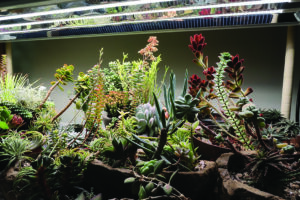
“You don’t have to be a tropical plant aficionado to use (plant lights), and anyone with an available power outlet can try it,” said Miri Talabac, horticulture specialist for The University of Maryland Extension’s Home and Garden Information Center. “Setups can be as simple or as complex as you’d like.” (Photo courtesy Miri Talabac)
The season for “decking the halls” with festive greenery has passed. But having indoor plants through the winter can keep the joy coming, while also enhancing our physical and emotional health.
But partaking of those benefits can be challenging for those with limited window space and sunlight exposure. It’s a problem Miri Talabac understands and is now helping others overcome.
Years ago, with a dimly lit basement serving as her home’s de facto cat free zone, the daring idea to transform the space into a plant cultivation oasis began growing. Starting with a simple hand-me-down plant stand used to grow African violets, her indoor garden took root, flourishing into a long lasting and rewarding hobby she affectionately refers to as “my descent into houseplant madness.”
Talabac, horticulture specialist for The University of Maryland Extension’s Home and Garden Information Center, who also answers garden questions for Baltimore Sun readers, has compiled An Introduction to Gardening Under Lights, on the Maryland Grows blog (https://marylandgrows.umd.edu/).
The four-to-five-part series began Nov. 29 and continues through February (alternating with other featured weekly topics), taking readers through the ins and outs of gardening under lights. It’s aimed for both newcomers curious about a different way to grow plants and more experienced growers wanting to build on their understanding of lighting possibilities.
“You don’t have to be a tropical plant aficionado to use them, and anyone with an available power outlet can try it. Setups can be as simple or as complex as you’d like,” Talabac coaches readers.
While spotlighting an array of discussion topics, “essentially, the take-home message is that fancy, expensive, or high-tech plant lights aren’t necessary for decent results. More important is understanding what each one’s specifications mean in terms of helping you fit the best fixture/bulb to your budget and growing needs,” she noted.
Another basic lesson is to choose lights with a spectrum as close to sunlight as possible; use them to either supplement natural light or to be the sole light source. People generally don’t realize how poor their home or office lighting is when it comes to plant photosynthesis, Talabac added.
“Impacting photosynthesis and growth, the red and blue ends of the visible light spectrum play the largest role. Still, other colors are used by plants, including some we can’t see (like far-red). Some wavelengths (light color) are important in regulating flowering, leaf growth, fruiting, stretching or compactness of the stems, and so on,” Talabac continued.
“In the blog, I equate light to food for plants, which need a certain number of calories a day via photosynthesis. They can nibble on small snacks for many hours or they can eat one or two heavier meals then little else the rest of the day and still come out having consumed about the same number of calories. It’s similar with light – they can either get a certain number of hours at moderate-intensity light and be satisfied for the day or get a longer number of hours of lower-intensity light and come out the same.”
“So long as the more intense light isn’t strong enough to damage the leaves, and provided plants receive their “rest” of darkness, you can play around with how you “feed” them based on your lighting options and what’s convenient for you. I put my lights on a timer so they come on for a set number of hours each day. (About 13 in my case, and I do not use window light),” she explained.
“Plants need a period of darkness to grow normally, so you can’t just run dim lights 18-24 hours a day and get the same benefits as better lights on for, say, 12 hours. Plus, some plants (especially flowering as opposed to just foliage) depend on this light-dark cycle to know when to bloom,” she explained.
Traditionally more expensive, LED lights are currently coming down in price and gaining in popularity over the old standby fluorescents, Talabac added. LEDs are more energy-efficient and use less wattage for a similar level of brightness. While both LEDs and fluorescents can have somewhat customizable light spectra, LEDs are probably even more customizable since a mixture of diodes (the actual light emitters) can be blended to create a unique color palette of light (even when it looks white to us), she pointed out.
“Another advantage to LEDs is the lower risk factor if one breaks, since fluorescent tubes are glass and might contain mercury, whereas LED “tubes” are plastic-covered and do not. Both can stop working at some point for an array of technical reasons, but LEDs generally have a much longer usable life,” she noted.
“My own setup uses a hodge-podge of light fixtures on different shelves of my plant stands because it’s what I’ve acquired or used as hand-me-down options over the years. I only replace what needs it due to wear-and-tear. Therefore, I have both a T-12 fluorescent fixture (really going back decades with that one), a T-5 high-output fixture, and two different styles of LED fixtures. They all work fine, and I just put the plants under the fixture that best matches the intensity they need,” she said.




